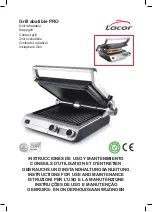
8
ENGLISH
(Original instructions)
Battery state of charge indicator (Fig. B)
The battery includes a state of charge indicator to quickly
determine the extent of battery life as shown in figure B. By
pressing the state of charge button (4a) you can easily view
the charge remaining in the battery as illustrated in figure B.
Installing and Removing the Battery Pack from
the tool
Warning!
Make certain the lock-off button is engaged to
prevent switch actuation before removing or installing battery.
To install battery pack (Fig. C)
u
Insert battery pack firmly into tool until an audible click is
heard as shown in figure C. Ensure battery pack is fully
seated and fully latched into position.
To remove battery pack (Fig. D)
u
Depress the battery release button (4b) as shown in
figure D and pull battery pack out of tool.
Attaching hook and loop sanding discs (Fig. E)
For best results, use STANLEY FATMAX accessories.
u
Your sander is designed for use with either mesh carbide
sandpaper or with standard sand paper with the 8 hole
dust extraction pattern.
u
To attach the sanding disc (7), carefully center it over the
sanding pad (3) ensuring the holes in the disc align with
the holes in the pad and press the disc firmly in place.
u
The hook and loop fastening system sanding disc can be
easily removed by simply pulling it off. It can be reused
as desired.
Use
Warning!
Let the tool work at its own pace. Do not overload.
Switching on and off (Fig. F)
u
To switch the tool on, depress the on/off switch (2) at the
"I" position.
u
To switch the tool off, depress the on/off switch (2) at
the"O" position.
Operation (Fig.G)
Grasp the sander as shown in figure G and turn it ON
.
Move it
in long, sweeping strokes along the surface, letting it do
the work
.
Pushing down on the tool while sanding actually slows the
removal rate and produces an inferior quality finish.
Check your work often. Sander is capable of removing
material rapidly especially with coarse paper.
Dust Collection
Warning!
Collected sanding dust from sanding surface
coatings (polyurethane, linseed oil, etc.) can self=ignite and
cause fire. To reduce risk, strictly follow sander manual and
coating manufacturer’s instructions.
Connecting a vacuum cleaner (Fig. H)
u
Insert the hose (9) of the vacuum cleaner into the dust
extraction outlet (5).
Maintenance
Your tool has been designed to operate over a long period of
time with a minimum of maintenance. Continuous satisfactory
operation depends upon proper tool care and regular cleaning.
Warning!
Before performing any maintenance, switch off and
unplug the tool.
u
Regularly clean the ventilation slots in your tool using a
soft brush or dry cloth.
u
Regularly clean the motor housing using a damp cloth. Do
not use any abrasive or solvent-based cleaner.
Protecting the environment
Z
Separate collection. Products and batteries marked
with this symbol must not be disposed of with
normal household waste.
Products and batteries contain materials that can be
recovered or recycled reducing the demand for raw materials.
Please recycle electrical products and batteries according to
local provisions. Further information is available at
www.2helpU.com









































